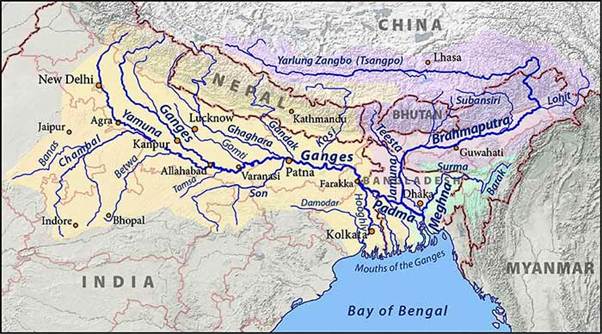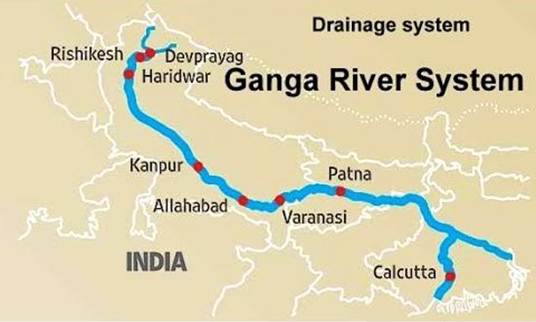Content :
- Let the Rivers Talk to Each Other
- Aiding India’s progress with choice, control and capital
Let the Rivers Talk to Each Other
India’s rivers, especially the Yamuna and Ganga, are lifelines that sustain ecology, economy, and culture. However, urban pollution, fragmented governance, and lack of basin-scale planning threaten their health. Integrating rejuvenation efforts under a unified, systems-based approach is key to restoring their vitality.
Relevance : GS 1 (Geography, Society), GS 2 (Governance, Federalism), GS 3 (Environment, Economy, SDGs)
Practice Question : “River rejuvenation in India requires a shift from fragmented interventions to integrated basin-level governance.” Critically examine this statement in the context of Yamuna and Ganga restoration efforts.(250 words)

Why Yamuna’s Revival is Nationally Strategic
- The 22-km Delhi stretch of the Yamuna contributes nearly 76% of the river’s total pollution load, though it comprises only about 2% of the river’s length.
- As a major tributary of the Ganga, the Yamuna’s health directly affects the broader Ganga river basin ecosystem and must be treated as an integrated hydrological unit.
Namami Gange as an Institutional Backbone
- Namami Gange Programme (NGP), launched in 2014, has received over ₹37,000 crore in allocations and sanctioned 400+ projects across pollution control, biodiversity, and public awareness.
- It is anchored by the National Ganga Council (NGC), chaired by the Prime Minister, with key ministries and Chief Ministers of basin states as members.
- Innovations include:
- Hybrid Annuity Model (HAM) for sewage treatment infrastructure
- District Ganga Committees, real-time pollution monitoring, and Ganga Task Forces for ground-level enforcement.
Need for Basin-Scale Integration
- The current approach to the Yamuna focuses on isolated interventions like STPs or beautification efforts, lacking catchment-wide governance.
- Pollution inflow from Haryana and Uttar Pradesh remains unchecked due to absence of cross-jurisdictional coordination.
- Integrating the Yamuna project under NGP would enable systemic planning, pollution budgeting, and shared accountability across basin states.
Policy Recommendations for Convergence
- Treat Yamuna as a pilot urban river node under Namami Gange for testing basin-scale integration.
- Create Urban River Management Units (URMUs) under the NGC to coordinate city-specific pollution and rejuvenation efforts.
- Institutionalize river-to-river knowledge transfer, supported by hydrological data sharing and ecological planning frameworks.
- Promote citizen participation, corporate social responsibility (CSR), and impact investments for decentralized monitoring and community-driven river health programs.
International Best Practices to Emulate
- The Rhine River Basin restoration (Europe) shows success through multi-country catchment cooperation and pollution source elimination.
- Chicago River (USA) rejuvenation demonstrates the impact of grey-green infrastructure investment and stormwater planning.
- Lessons from these models point to the need for collaborative governance, transparency, and systems thinking.
Reimagining River Rejuvenation in India
- River restoration must move beyond engineering solutions to include ecological, social, and economic dimensions.
- Integrating Yamuna rejuvenation into the Namami Gange framework can serve as a template for managing other polluted rivers, especially in urban India.
- This convergence will help achieve goals of clean water, climate resilience, and healthy ecosystems, aligning with SDG 6 (Clean Water and Sanitation) and SDG 11 (Sustainable Cities).
Broader Dimensions
Governance & Federalism
- Cooperative Federalism: River rejuvenation requires coordination across central ministries, basin states (Delhi, Haryana, UP), and urban local bodies.
- Institutional Innovation: Namami Gange’s architecture (NGC, DG, State Missions) offers a replicable governance model for other rivers.
- Mission-mode Governance: Shift from scheme-based to mission-based delivery improves convergence across sectors (urban planning, water, sanitation).
Environment & Sustainable Development (GS3)
- SDG Alignment:
- SDG 6 – Clean Water and Sanitation
- SDG 11 – Sustainable Cities
- SDG 13 & 15 – Climate Action and Life on Land
- Ecosystem Services: Restored rivers improve biodiversity, recharge aquifers, and act as climate buffers during floods and heatwaves.
Water Security & Agriculture
- Downstream Dependence: Ganga basin supports over 400 million people; polluted tributaries like the Yamuna threaten drinking water, irrigation, and livelihoods.
- Water-Energy-Food Nexus: Efficient river management optimizes use across competing sectors—urban consumption, agriculture, and industry.
Ethics & Intergenerational Equity
- Environmental Stewardship: Ethical obligation to protect rivers as shared public goods and cultural heritage.
- Future Generations: Sustainable river governance ensures ecological and resource security for coming generations.
Climate Resilience
- Nature-based Solutions: River rejuvenation using wetland restoration, floodplains, and riparian buffers supports urban resilience against extreme weather.
- Urban Flooding Mitigation: Healthy rivers with restored natural drainage systems reduce flood risk in cities like Delhi.
Yamuna River – Key Facts
- Origin: Yamunotri Glacier, Uttarkashi district, Uttarakhand (Altitude: ~6,387 m)
- Length: ~1,376 km
- States Traversed: Uttarakhand, Himachal Pradesh, Haryana, Delhi, Uttar Pradesh
- Major Cities Along Course: Yamunotri, Dehradun, Paonta Sahib, Karnal, Delhi, Agra, Mathura, Etawah, Allahabad (Prayagraj)
- Tributary of: Ganga (joins at Triveni Sangam, Prayagraj, UP)
Pollution Hotspot:
- Delhi stretch (~22 km) accounts for ~76% of total pollution load due to:
- Untreated sewage (70–80%)
- Industrial effluents
- Encroachments and solid waste
- Yamuna Action Plan (YAP): Initiated in 1993 (Japanese aid) – now in Phase III.
Ganga River – Key Facts
- Origin: Gangotri Glacier (Gaumukh), Uttarkashi district, Uttarakhand
- Main Stream Name Upstream: Bhagirathi
- Length: ~2,525 km (longest river in India)
- States Traversed: Uttarakhand, UP, Bihar, Jharkhand, West Bengal
- Empties into: Bay of Bengal (via the Hooghly–Padma distributaries)

River Basin:
- Covers ~26% of India’s land area
- Supports ~43% of India’s population (~500 million)
- World’s most populous river basin
Major Tributaries:
- Left Bank: Ramganga, Gomti, Ghaghara, Gandak, Kosi, Mahananda
- Right Bank: Yamuna, Son, Tamsa
Pollution Challenges:
- Over 1,000 drains discharge into Ganga; about 50% of pollution from just 10 cities.
- Namami Gange Programme (2014–ongoing): Integrated mission with ₹37,000+ crore allocation.
Conclusion
Restoring Yamuna and Ganga through integrated basin-level planning is vital for ensuring water security, ecological health, and sustainable urban development, making river rejuvenation a national development priority.
Aiding India’s progress with choice, control and capital
With global population exceeding 8 billion, the 2025 World Population Day theme – “Empowering young people to create the families they want in a fair and hopeful world” – rightly centers the discourse on reproductive rights, youth aspirations, and inclusive development. For India, home to the world’s largest youth population, the challenge is not just numbers but ensuring reproductive freedom, economic empowerment, and dignity for all.
Relevance: GS 1(Society: Women and youth issues, child marriage) , GS 2 (Governance: Health, education, and welfare policies)
Practice Question: “India’s demographic dividend will only yield results if the reproductive aspirations and economic agency of its youth are fulfilled.” Critically examine in the context of declining fertility and persistent gender inequality. (250 Words)
India’s Demographic Opportunity
- 371 million youth (15–29 yrs), per UNICEF – largest globally.
- World Bank & NITI Aayog project $1 trillion GDP boost by 2030 if investments are made in youth health, education, and employment.
- However, declining Total Fertility Rate (TFR) (NFHS-5: 2.0) raises questions on future workforce potential.
Reproductive Autonomy: A Crisis in Aspiration
- 36% adults face unintended pregnancies; 30% report unmet fertility goals.
- 23% experience both, revealing systemic failures in enabling informed reproductive choices.
- Fertility aspirations are unmet not due to disinterest but due to barriers: poor access to services, stigma, and patriarchal norms.
Child Marriage & Early Pregnancy
- NFHS-5: Child marriage reduced from 47% (2006) to 23.3%, yet remains high.
- Teenage childbearing among 15–19 years: 7% nationally, >15% in some states.
- UNICEF: 1 year of secondary education → 6% reduction in child marriage likelihood.
Model Interventions
- Project Udaan (Rajasthan, 2017–22): 30,000 child marriages prevented; 15,000 teenage pregnancies averted through education, scholarships, contraceptive access.
- Advika (Odisha): 11,000 villages declared child marriage-free; 950 prevented in 2022 alone.
- Project Manzil (2019–25): Trained 28,000 young women; 16,000 employed – boosted agency, delayed marriage through economic empowerment.
Global Fertility Crisis: Misplaced Alarmism
- UNFPA 2025: 1 in 5 globally can’t realize desired family size.
- India-specific factors: financial constraints (38%), housing (22%), childcare (18%), unemployment (21%).
- UN projections: Population will peak at 10.3 billion by 2080s; concerns of “collapse” are premature and politically charged.
Policy Lessons from Korea & Others
- Korea spent $200 billion to raise birth rates (2005–2025) → only a 7.3% birth rebound in Q1 2025.
- Shows monetary incentives alone fail unless structural barriers (gender roles, employment norms, housing) are addressed.
India’s Policy Gaps & the Way Forward
- Achievements: Beti Bachao Beti Padhao, National Adolescent Health Programme, NFHS-5 progress.
- Gaps:
- Unequal access to SRH (sexual & reproductive health) services.
- Low female labour force participation (~25%).
- Persistent stigma around contraceptives and abortion.
- Structural Needs:
- Universal access to contraceptives, safe abortion, maternal care.
- Removal of societal barriers: gender norms, mobility, childcare.
- Reforms in workplace policies: flexible hours, maternity protections, remote work options.
- Strengthened adolescent-centric, rights-based SRH education.
Conclusion:
India stands at a pivotal juncture. While demographic numbers create headlines, it is the quality of agency, autonomy and access that will determine whether its youth become assets or are left behind. Shifting from fertility control to reproductive choice and from token schemes to structural empowerment is essential. For India’s future to be fair, hopeful, and inclusive, the voice and freedom of every young person—especially every young woman—must be placed at the heart of policy.
Data and Facts
India’s Youth & Demographics
- Population (2024): 1.43 billion
- Youth (15–29 yrs): 371 million (UNICEF)
- Median age: 28.2 years
- Dependency ratio: 47.6% (2021)
Fertility & Reproductive Trends
- TFR (NFHS-5): 2.0 (Urban: 1.6; Rural: 2.1)
- States below replacement TFR: 23/36
- Teenage pregnancy (15–19 yrs): 6.8% nationally
- Unintended pregnancies: 36%
- Unmet contraceptive need: 9.4%
- Male sterilization usage: <1%
Child Marriage
- Prevalence (NFHS-5): 23.3% of women (20–24) married before 18
- India’s share of global child brides: 1 in 3 (UNICEF)
SRH & Health Indicators
- Modern contraceptive use: 56.5%
- Maternal Mortality Ratio (MMR): 97 per 100,000 (2020–22)
- Adolescent fertility rate: 24/1,000 women (15–19 yrs)
Women’s Autonomy & Work
- Female LFPR (2022–23): 37% (↑ from 23% in 2017–18)
- Youth female LFPR (15–24 yrs): ~23%
- Women involved in health decisions: 74% (NFHS-5)
Global Context
- Global population (2024): 8.2 billion
- Peak projected: 10.3 billion (2080s, UN WPP 2024)
- South Korea’s TFR: 0.72; spent $200B on fertility push
- UNFPA 2025 Report: 40% globally unable to meet fertility aspirations



